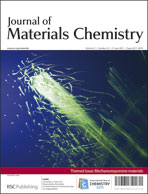Difluoroboron β-diketone complexes are versatile light-emitting molecules that exhibit tunable emission in both solution and the solid state. Among this class of dyes, difluoroboron dibenzoylmethane-polylactide (BF2dbmPLA) polymers have been investigated for their molecular weight dependent fluorescence where the polymer chain plays an important role in BF2dbm solid-state emission. Here the substituent effects were further examined with a lipid chain replacing polylactide. Surprising process dependent and reversible mechanochromic fluorescence was discovered for the boron dodecane complex (BF2dbmOC12H25). A thermally annealed spin-cast film of the lipid dye on glass exhibited blue fluorescence under UV light but after shearing or scratching, the mechanically perturbed region turned yellow-green. The blue coloration could be rapidly recovered by thermal treatment of the film. The phenomena were investigated by steady-state fluorescence spectroscopy at room, low, and high temperatures, in situfluorescence microscopy, fluorescence lifetime measurements, and X-ray diffraction. Consistent with previous findings, the ordered-to-amorphous structural change that occurs upon mechanical perturbation may increase molecular rotational freedom, allowing for more efficient excimer emission, which typically occurs at longer wavelengths.

You have access to this article
 Please wait while we load your content...
Something went wrong. Try again?
Please wait while we load your content...
Something went wrong. Try again?


 Please wait while we load your content...
Please wait while we load your content...